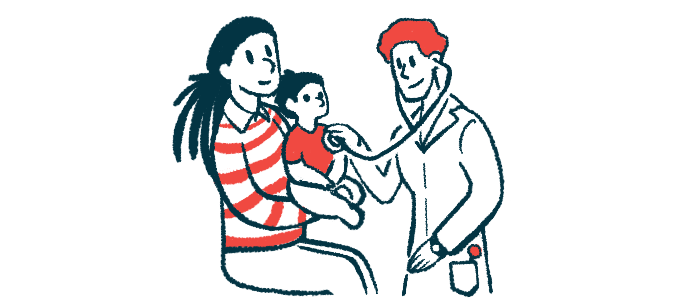Experts offer new guidance for patient care after Upstaza
Recommendations: Intensive physical therapy, age-appropriate rehab support

Following gene therapy, people with AADC deficiency should receive a few weeks of intensive physical therapy, with additional physical therapy and age-appropriate rehabilitative support in the months and years that follow.
That’s according to new recommendations put forward in a paper, “A position statement on the post gene-therapy rehabilitation of aromatic I-amino acid decarboxylase deficiency patients,” published in the Orphanet Journal of Rare Diseases.
Gene therapy Upstaza approved in EU, UK for AADC deficiency
The gene therapy Upstaza (eladocagene exuparvovec) is approved for AADC deficiency in the European Union and in the U.K., and its maker PTC Therapeutics is expected to seek approval soon in the U.S. as well.
Upstaza is a one-time gene therapy delivering a functional version of the DDC gene, defects of which cause AADC deficiency. Clinical trials have shown it can substantially improve motor function for children with AADC deficiency.
In this paper, an international group of experts put forward recommendations for the types of care that children should receive after Upstaza to maximize benefits from the gene therapy.
“Now that a gene therapy with demonstrated efficacy for AADC deficiency has been approved, there is an urgent need for development of post-treatment therapy guidelines to maximize improvements of motor function following gene therapy,” the scientists wrote.
They noted that, since AADC deficiency is extremely rare and gene therapy is a very recent development, there’s not much hard data to go on, so these recommendations are based mostly on expert opinion and personal experiences.
To ensure patients can reach their full potential following treatment with gene therapy, it is essential they receive rehabilitation therapies designed specifically with their impairments and goals in mind.
Framework based on experiences of therapists, physicians, parents/caregivers
“This article highlights specific rehabilitative needs of patients following gene therapy and proposes a framework based on experiences of therapists, physicians, and parents/caregivers involved in treating and caring for patients with AADC deficiency following gene therapy,” they wrote.
The recommendations state that patients should receive intensive physical therapy — typically consisting of short bursts of intense exercises for several hours each day — for the first three or four weeks following gene therapy. This may be done by keeping the patient in hospital for a few weeks to receive care, or by frequent therapy sessions elsewhere.
After the first weeks of intensive rehab, care should transition to at-home therapy. In addition to working to build strength and motor skills, an important goal of at-home therapy is to help families build routines and develop functional strategies.
Physical therapy should be done at least twice per week for the first six to 12 months after gene therapy. After that, patients should continue to receive regular physical therapy sessions and check-ins indefinitely. “Continued rehabilitation is essential for maximizing patient improvements,” the researchers wrote.
Physical therapy to promote active movement in daily life
A particular goal of physical therapy for AADC deficiency is to promote active movement, getting the patient to proactively move around as much as possible. Ideally, this is done by focusing therapies on movements that can be done during day-to-day life.
“As patients gradually gain movement repertoires following gene therapy, practicing and maximizing available active movements in a functional context is important for further motor skill development,” the researchers wrote. “This allows the patient to practice their motor skills by incorporating them throughout their day rather than solely practicing these movements in therapy sessions.”
The scientists also emphasized the importance of incorporating play and natural curiosity into rehabilitation for children with AADC deficiency.
“Playing provides patients with age-appropriate experiences and exposure to a variety of objects with which they can physically interact. As the patient is focused on playing, an enjoyable activity, they become less focused on the motor demands of the activity and more motivated and engaged with the activity,” the researchers wrote.
They noted that playful therapies are also typically easy for children to engage in outside of therapy sessions, adding the benefits of play “extend beyond motor development; play can reduce stress, improve self-confidence, and promote creativity, emotional regulation, problem-solving, and language development in children.”
Age-appropriate therapies also critical to stimulate other areas of development
Although physical therapy is a major focus of care for AADC deficiency after gene therapy, age-appropriate therapies are also critical to stimulate other areas of development, such as sensory processing, language, and social interaction. Many patients also benefit from assistive devices like gait trainers or walkers that provide trunk support.
Specialized supplemental therapies such as aquatic therapy (physical therapy done in water), hippotherapy (done on horseback), or music therapy may also benefit patients with AADC deficiency following gene therapy. Since AADC deficiency affects everyone differently, the specific types of therapies given should be tailored to the needs of the patient, and the researchers emphasized the importance of a multidisciplinary care team to provide all the support needed.
“To ensure patients can reach their full potential following treatment with gene therapy, it is essential they receive rehabilitation therapies designed specifically with their impairments and goals in mind,” the researchers wrote.
They also emphasized the importance of caregivers in providing needed therapy to kids with AADC deficiency, stressing that clinicians should connect caregivers with emotional and mental support as well as financial assistance resources wherever possible.








